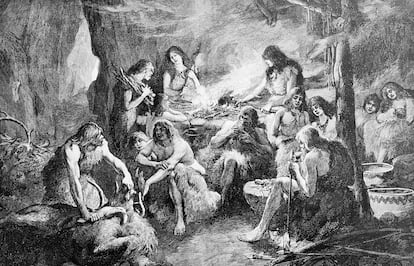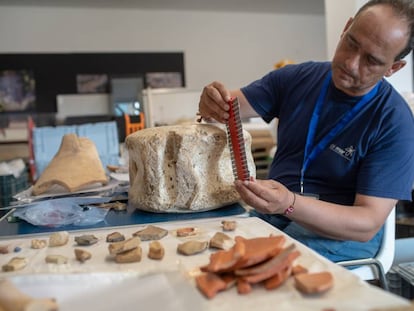We are ‘cooknivores’: How cooking forever changed our digestive systems
Preparing food with heat drastically modified the anatomy and physiology of human beings and made us different from other animals, so much so that it’s no longer a choice: a strict raw diet implies health problems

Humans have many characteristics that differentiate us from other animals. In addition to cultural and social distinctions, certain anatomical and physiological qualities make us stand out. The most well-known is our brain development, but there are others, like the little-known particularities of our digestive system.
The differences are not just the digestive tract itself, but also in our jaw shape, teeth and our chewing capacity (deficient when compared with any other animal). Even other primates, our closest living relatives, share little in common with our digestion. These differences have formed part of an evolutionary process in which fire had a determining role: it’s not that we evolved to be able to control fire, but thanks to it, we experienced a series of astonishing changes.
The origin of our differences
Many have studied and speculated about the causes of our differences, but only recently have we begun to understand the crucial importance of being the only animal that cooks. All known groups of humans cook. Though cooking may not explain everything that sets us apart from other species, it accounts for many of them, to the point that not cooking is no longer possible for humans.
We classify animals according to their diets as carnivores, omnivores, herbivores and frugivores. Humans are classified as omnivores. But if we couldn’t prepare and cook food, we would probably face serious caloric and nutritional deficits. Since we depend on cooking and other food preparation and conservation techniques, we should add another characteristic. Our most important dietary specification is eating cooked food: we are ‘cooknivores.’

The energy paradox
Based on our biological characteristics, humans could be considered a waste of energy. Our usage is much higher than that of other mammals. One study compares the energy use of humans to that of chimpanzees, with whom we share 98% of our genetic material. Human men used 44% more energy than their chimpanzee counterparts when completing the same task (hunting-gathering).
There are many other studies on the topic, and they all get at the same thing: we use much more energy than our closest relatives, without taking into account our brains’ exceptional energetic demands. These differences could be explained if humans dedicated more time to getting energy or if we had more efficient digestive structures (or both). But the reality couldn’t be more different.
Chimpanzees chew their food for four to six hours a day, while humans spend barely an hour doing so. In comparison with non-human primates, we have smaller oral cavities, jaws and teeth, and weaker chewing muscles. Even our digestive system is, proportionally, shorter, and therefore less efficient.
Humans’ physiological investment in digestion is also lower than expected: we spend between six and seven percent of our energy on it, compared with the average 13% to 16% among other mammals. We use much more energy and we have fewer biological resources to obtain it. How can we explain this paradox?
Outsourcing digestion
Scientific works on the topic define cooking as the use of heat to prepare food. There are other forms of processing foods, like cutting, milling and fermenting. But none of those processes match the net nutritional gains that we owe to cooking.
Only the use of heat can transform food, whether animal or vegetable, enough to understand humans’ singularity regarding energetic efficiency in food. Cooking decreases the effort necessary to process food: less chewing, less need for digestive enzymes and less total digestion time. And it makes energy and nutrients in food more available than if it were consumed raw.
Saving energy by not getting sick
Cooking, beyond the strictly nutritional issues and the investment compared to obtaining energy, brings an important added value: heat sanitizes, and in some cases sterilizes, food. For primitive humans, it represented a giant step forward in the use of physiological resources and, therefore, evolution. The study “The Energetic Significance of Cooking” leaves some important reflections: according to the authors’ calculations, whatever cooking methods are used, the average energy cost due to dietary diseases is equivalent to the energy expenditure of a single day in the context of a 75-year life span. But if we did not cook our food, we would face an energy expenditure equivalent to that of 6.9 years.
These calculations suggest that, if food were not cooked, consumers would fall ill an average of 42 times a year and would have a fever for 145 days each year.
You will know them by their intestines
Most animal species are highly specialized when it comes to nutrition. They can eat only certain foods. For those considered “higher animals” —an obsolete term, but which I use because it is particularly vivid— the anatomical diversity of the digestive tract is astonishing, as highlighted in this study. Compared to the digestive tract of humans:
Pigs, omnivorous animals, have a small intestine almost twice as long.
In the case of orangutans, which are typically frugivores but sometimes eat meat and are therefore considered omnivores, the same is true: the small intestine is much longer than that of humans.
The dog, a typical carnivore, has a much shorter colon than the human, as well as a reduced cecum.
In the case of any herbivorous species, whether ruminants such as sheep or horses or non-ruminants such as kangaroos, we find large intestinal space dedicated to the fermentation of food material.
Koalas, which almost exclusively consume eucalyptus leaves, have a very small small intestine and a very large large intestine.
These examples serve to highlight that no mammal is a universal digester. On the contrary, they have all specialized in eating certain things, but not others. After observing their digestive characteristics and comparing them with those of humans, it is clear that our food choices should be much more limited than they actually are, and that if they have diversified to the point of doing as we do, it has been thanks to the cooking of food.
Raw diets are not for us
Raw food is a trending topic from time to time. Influencers spout the hyperbolic wonders of different eating trends, including avoiding consuming anything that has been heated above 48ºC. The limit has been set at 48ºC because it is supposed to be the maximum “natural” temperature at which you can find food heated by the action of the sun. But in the eyes of science, these supposed wonders are trending towards utopic: a good number of studies say so.
In general, strict raw diets have a significant risk of being insufficient in energy intake and deficient in certain vitamins and minerals. There are not many publications that address the consequences of a raw vegan diet, but the available evidence suggests that raw foodists have compromised physiological performance. Raw vegans have a higher Body Mass Index (BMI) than those who primarily eat raw foods. The median BMI of healthy adults consuming cooked vegetarian diets was 23.7 (women) and 24.3 (men), compared to 20.1 (women), 20.7 (men) for those eating predominantly raw foods.
The same study pointed out the absence of menstruation, or amenorrhea, in 23% of women of childbearing age who consumed at least 70% of their food raw. It was observed in 50% of the women who said they followed a 100% raw diet. The reason, again, is probably the raw diet: the amenorrhea data in the female vegetarian cooking population are the same as in the general population. Moreover, the inclusion of (raw) meat does not improve the outcome of women who follow raw diets. The energy cost of eating raw is clear.
These data refer to crudivores who are at the same time members of urban communities, where habitual levels of activity are lower than those observed in traditional hunter-gatherer or pastoralist communities. Their food choices, although consumed raw, are of a particular quality within the possible choices (seeds, sprouts, fruits, nuts and cereals and virgin vegetable oils). A nutritional analysis suggested that a diet based on raw wild foods would have an even lower energy value, to the point of hindering survival and reproduction.
Sign up for our weekly newsletter to get more English-language news coverage from EL PAÍS USA Edition
Tu suscripción se está usando en otro dispositivo
¿Quieres añadir otro usuario a tu suscripción?
Si continúas leyendo en este dispositivo, no se podrá leer en el otro.
FlechaTu suscripción se está usando en otro dispositivo y solo puedes acceder a EL PAÍS desde un dispositivo a la vez.
Si quieres compartir tu cuenta, cambia tu suscripción a la modalidad Premium, así podrás añadir otro usuario. Cada uno accederá con su propia cuenta de email, lo que os permitirá personalizar vuestra experiencia en EL PAÍS.
¿Tienes una suscripción de empresa? Accede aquí para contratar más cuentas.
En el caso de no saber quién está usando tu cuenta, te recomendamos cambiar tu contraseña aquí.
Si decides continuar compartiendo tu cuenta, este mensaje se mostrará en tu dispositivo y en el de la otra persona que está usando tu cuenta de forma indefinida, afectando a tu experiencia de lectura. Puedes consultar aquí los términos y condiciones de la suscripción digital.
More information
Archived In
Últimas noticias
Half of Scotland is in the hands of 420 property owners
Reinhard Genzel, Nobel laureate in physics: ‘One-minute videos will never give you the truth’
Pinochet’s victims grapple with José Antonio Kast’s rise in Chile
From digital curfews to blocking apps: How technology experts protect their children online
Most viewed
- Pablo Escobar’s hippos: A serious environmental problem, 40 years on
- Reinhard Genzel, Nobel laureate in physics: ‘One-minute videos will never give you the truth’
- Why we lost the habit of sleeping in two segments and how that changed our sense of time
- Charles Dubouloz, mountaineering star, retires at 36 with a farewell tour inspired by Walter Bonatti
- The Florida Keys tourist paradise is besieged by immigration agents: ‘We’ve never seen anything like this’











































